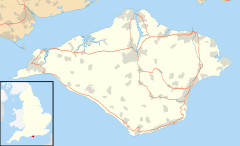Luccombe Bay facts for kids
Quick facts for kids Luccombe Bay |
|
|---|---|
 Luccombe Bay looking to the north |
|
| Civil parish | |
| Ceremonial county | |
| Region | |
| Country | England |
| Sovereign state | United Kingdom |
| EU Parliament | South East England |
| UK Parliament |
|
Luccombe Bay is a beautiful bay located on the south-east coast of the Isle of Wight in England. It gets its name from the nearby Luccombe Village, which is just to its west. The bay faces the English Channel and offers lovely views of the sea.
Exploring Luccombe Bay
Luccombe Bay has a shoreline that stretches for about 2⁄3 mile (1.1 km). The beach is a mix of sand and shingle, which are small, smooth stones. Behind the beach, you'll find impressive sea cliffs. These cliffs are quite tall, reaching heights of about 200 to 280 feet (60 to 85 m). The bay itself extends from a spot called Horse Ledge in the north down to Bordwood Ledge in the south. The seabed here is made up of mud and rocks.
The Luccombe and Landslip Walk
High above the cliffs that surround Luccombe Bay, there's a special walking trail. This path is part of the National Trust and is called the Luccombe and Landslip Walk. It's about 4+1⁄2-mile (7.2 km) long and offers amazing views of the bay and the surrounding landscape. You can learn more about this walk on the National Trust website.
Luccombe Chine and Coastal Changes
One of the best places to see Luccombe Bay is from Luccombe Chine. A "chine" is a steep, narrow valley that has been carved out by a stream flowing to the sea. Luccombe Chine leads down to the beach about two-thirds of the way along the bay.
There used to be a wooden footpath with steps leading from the coastal path down to the beach. However, this path is currently closed. It was damaged by natural events called landslips. A landslip happens when a large mass of rock, soil, or debris moves down a slope.
The area around Luccombe Bay experiences a lot of erosion. This means the cliffs are slowly worn away by the sea and weather. The cliffs here are retreating, or moving back, by about a foot (30 cm) each year. This natural process constantly reshapes the coastline.


